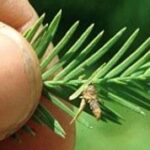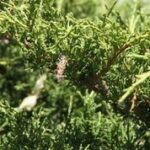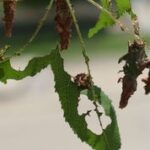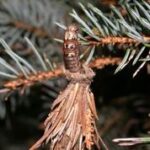Early summer is a great time to protect trees and shrubs from bagworms. By this time, they have had a few weeks to feed and have become large enough to find, even though they try to hide by covering themselves with leaves. Typically, these insects are found on evergreen trees and shrubs, like junipers, spruce, pines and arborvitae. Some deciduous trees, however, like, maples, oak, elm and honeylocust are routinely attacked.
Bagworm life cycle
Bagworms are flightless moths who spend the winter as eggs laid by their mother in silken cases covered with dried leaves. Eggs hatch into small (1/8”) caterpillars in late spring that dangle on silks as they drop to the foliage below the bag. Most of the caterpillars remain on the plant and start eating leaves and needles. Each young caterpillar covers itself with bits of leaves to hide from birds. Many will crawl toward the tops of trees and can be blown up to 30 feet to nearby plants. Caterpillars feed through mid-August before they become adults. Wingless adult females remain in their bags allowing winged males to fly to them to mate. After mating the females will lay eggs in the silken sack where bagworms spend the winter.
Summer Management of Bagworms
If you find bagworms feeding on your trees or shrubs you can control the problem with a foliar spray of an insecticide. There are simply too many small caterpillars for you to hand remove them from a plant. Delaying a spray allows the caterpillars to get larger, and remove more foliage. Evergreen trees and shrubs, the favored hosts of bagworms, are less tolerant of defoliation than deciduous trees that lose their leaves each fall. Unfortunately, while some systemic insecticides available to professionals (dinotefuran) can kill bagworms, they are only effective on smaller shrubs (< 6 ft tall), and have been associated with outbreaks of spider mites later in the season. There are no products homeowners can apply to the base of tall trees to control this pest.
Spinosad (Fertilome Borer and Bagworm killer, Captain Jack’s Deadbug) can be applied to leaves and is very effective at killing caterpillars. Some formulations of this insecticide (eg, Monterrey Garden Insect Spray) are OMRI approved, and can be used by organic farmers. Bacillus thuringiensis (Dipel, Thuricide), is another effective caterpillar killer with OMRI approved products but is most effective when bagworms are < 1” long.
Other insecticides available to homeowners (eg, carbaryl, permethrin, lambda-cyhalothrin) will kill these caterpillars, but will also kill the beneficial insects that eat predators of spider mites, and scale insects. Early season use of these products have been associated with later season problems with these other pests. For a more complete listing of this products available to homeowners and professionals see our bulletin on bagworms.
Use the Purdue Tree Doctor app to get a diagnosis and a recommendation for bagworms and other pests.
- Figure 1 Young bagworms that cover themselves with foliage can be difficult to see.
- Figure 2 Bagworms are easier to see in early summer when they are larger and some leaf bits on the bag have turned brown.
- Figure 3 Bagworms eating a maple leave and covering themselves with green foliage.
- Figure 4 In late July, large bagworm caterpillars can rapidly defoliate a plant.



